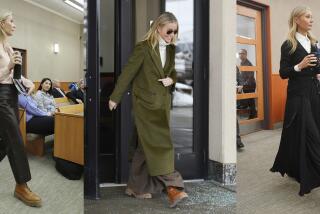Cashmere Brings a Soft Touch of Elegance That Can Be a ‘Fleece’
- Share via
If you crave a new touch of class, but Rolls-Royces and sapphires are out of the question, cashmere could be the answer.
For a princely sum--as opposed to a king’s ransom--you can wrap, drape or smother yourself in cashmere, the world’s softest, finest natural fiber. (Vicuna would hold the honor, but it’s been on the endangered-species list for years.)
Los Angeles department stores carry women’s cashmere garments that range in price from about $200 for a basic cardigan to more than several thousand dollars for designer separates. For men, the price range runs from about $80 for a two-ply vest to about $1,200 for an eight-ply cardigan.
To get your money’s worth, industry analysts advise that consumers read labels carefully, avoiding cashmere mixed with additives such as nylon and rabbit hair.
Pure Cashmere is rare and pricey for good reason. The world’s major source of supply is Inner Mongolia. There, and only in the month of June, the cashmere goats molt, each shedding just about four usable ounces of fleece.
The difficulty in assembling even the smallest item out of pure cashmere is illustrated in a quaint chart put out by Amicale Industries, a New York-based manufacturer of luxury fabrics. It shows 24 goats to a coat, 4 goats to a 2-ply dress, 3 goats to a man’s single-ply sweater, 2 goats to a woman’s single-ply sweater, 1 goat to a muffler.
Cashmere was originally named for Kashmir, the region of India to which the fleece was transported on camel and human backs, then woven into legendary “ring shawls,” used as the ultimate gifts exchanged by potentates.
The shawls acquired this special name, explains Dale Gluckman, assistant curator for costumes and textiles at the Los Angeles County Museum of Art, “because they were so fine and light they could be drawn through a ruler’s thumb ring.”
Cashmere’s legendary aura of extravagance is justifiable. Yet for all its richness, the “king of fibers,” as it’s known in textile circles, wears like iron and travels like a dream.
Sarah Worman, Robinson’s vice president of fashion merchandising, ranks cashmere as “the No. 1 yarn for Southern California because it can be worn year-round, depending upon the number of plies. A one-ply cashmere garment is just as cool as cotton.”
And with designers putting emphasis on opulence and femininity this season, cashmere is also the current height of fashion.
Bullocks Wilshire fashion director Rosemarie Troy ties some of the current cashmere excitement to a new color spectrum available this season: pastels and bright, hot colors.
Stores are carrying styles unlike any seen before. Everything from Ballantyne’s flower-strewn, cashmere sweater set and skirt to Donna Karan’s cashmere bodysuit and Peggy Jennings’ ultimate “something comfortable”: cashmere chiffon lingerie.
Herb Kosterlitz, president of the Florida-based Peggy Jennings Co., calls cashmere “the diamond of the textile industry.” But he’s careful when he chooses a gem.
“If it has too much fluff, it will ball and pill. If it has too little, it won’t look rich. I don’t believe in cashmere mixes at all. If something is a blend, you don’t know what you’re getting.”
Karl Spilhaus, executive director of the Boston- based Camel Hair and Cashmere Institute of America (CCIA) spends a good deal of his day analyzing the contents of expensive garments.
Spilhaus cautions buyers to read the labels before they buy cashmere garments.
“A cashmere-and-wool blend is not necessarily suspect,” he says. “You don’t have to avoid blends, but you want to be careful when there is nylon or fur added. Nylon is frequently added to strengthen the fabric, and rabbit hair is added to make it softer. Genuine cashmere is already strong and soft. It doesn’t need anything added.”
But the real thing to be wary of, Spilhaus says, is cashmere yarn spun or woven in Prato, Italy. That is where most of his bogus-cashmere finds have come from, he explains.
Spilhaus made similar statements about the Prato cashmere fabrics last spring. Italian deputy trade commissioner Luca Rostagno replied that the commission was unaware of any complaints of mislabeling.
In an interview with Newsday, Rostagno said: “The Prato mills are among the most reliable in the world. They are very famous and appreciated here. I have never heard any complaints.”
But Spilhaus this week stood by his statement.
By federal law, garments have to state whether the fabric is domestic or imported, but the labels do not have to state the fabric’s specific point of origin. This makes it difficult for consumers to differentiate one imported cashmere from another.
Stores can send CCIA a swatch of any cashmere (or camel hair) fabric they are suspicious of.
“We test it free of charge and in total confidence. We can have the answer back within a week,” Spilhaus says.
Earlier this week, a suit was filed against two leading East Coast department stores and a Massachusetts garment manufacturer, Spilhaus reports.
The suit seeks an injunction preventing the companies from marketing and distributing cashmere and cashmere-blend garments, which tests by an independent laboratory showed to be substantially mislabeled as to cashmere content.
Spilhaus suggests a number of precautions for consumers to ensure they don’t get stuck with inferior merchandise:
“If a bargain looks too good to be true, it probably isn’t a bargain. Cashmere is an expensive fiber, and you have to be prepared to pay luxury prices.
“Rely on good brand names and reputable stores. Check for poor workmanship. Manufacturers who cut corners when they put garments together might also feel free to take some liberties in labeling.”
Meanwhile, should any intrepid consumer want to whip up her own creme-de-la-creme cashmere garment, Murray Pepper, president of the Home Silk Shop, says fabrics are definitely available--for a price.
A black wool-and-cashmere jersey, for example, sells for $100 a yard. For those who can cut it, a classic black dress, Pepper calculates, will take about two yards. Styling by ERIN DONLEY






